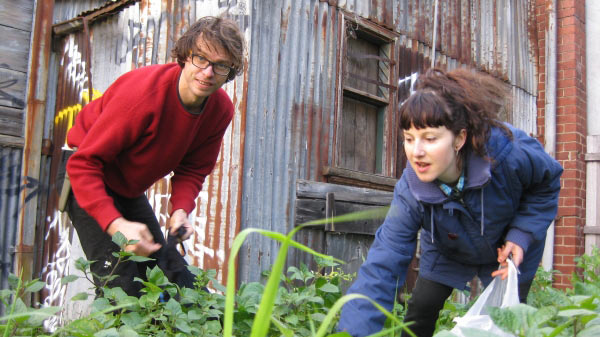There are still plenty of green tomatoes around and plenty of apples too, try this chutney recipe from Nathan’s mum Jenny. Included is advice on sterilizing jars and bottles. There is also a great idea for too many pumpkins and advice on storing your fresh herbs.
Green Tomato and Apple Chutney
This is a great way to use up your misshapen tomatoes or those that won’t ripen !
1 kg green tomatoes chopped
500 gms green apples peeled and chopped
500 gms onions peeled and chopped
2 cloves garlic, chopped
1 cup sultana or raisins
1 tblspn fresh ginger, chopped
1 tblspn sea salt
½ tspn each of coriander and mustard seeds, chilli flakes and ground pepper
6 cloves
2 cups apple cider vinegar
100gm brown sugar
Combine all ingredients in a saucepan except vinegar and sugar, mixing well. Add about half the vinegar and cook over low heat. Gradually add the remaining vinegar as the mixture boils. Stir in the sugar. Stir frequently to prevent sticking as the mixture thickens. Simmer for about an hour (or longer if you want a thicker consistency).
When thick, transfer to sterilized jars, see below.
Sterilising Jars
All pickles, jams, chutneys etc should be stored in sterilised jars. This is to prevent the growth of bacteria such as e.coli and is essential in any cooking of jams, preserves or relishes.
Wash the containers and lids thoroughly in hot, soapy water.
Use only glass or metal lids and containers. Place in large saucepan of water, bring to the boil and simmer for 10 minutes.
Transfer the boiling hot relish into the jars as soon as you remove them from the simmering water and immediately put a lid on. If you use pop-top lids they will pop down if the seal is air-tight. If it’s not air tight, move the jar to the fridge and eat it first. The rest should store for a couple of years.
Note: If you’re storing low-acid foods this way (tomatoes, relishes and anything with vinegar are no worry) you need to be very careful to 100% fully sterilise. Consult a good book like Putting Food By.
Here’s something you can do with your pumpkins all winter long (Autumn is a great time to get started though).
Jen’s Best Spicy Pumpkin and Coconut soup
I dare you not to love this!
2kgs pumpkin
2 onions
4 cloves garlic
2 tblspns fresh ginger
2 small fresh chillis
3 tspns ground cumin
2 tspns ground coriander
½ tspn cinnamon
1 tplspn curry paste
2 tblspns tomato paste
1 can tomatoes
1 can lite coconut cream
Firstly, chop everything. Lightly fry the garlic, onions and chilli for a few minutes. Add spices, curry and tomato pastes. Mmmm – smelly Yum already!! Tip in the pumpkin and stir. Add tomatoes, a tablespoon of sugar, a dash of salt and pepper and about 6 or 7 cups of water. Bring to the boil, then simmer. Cool off a bit and blend it with a hand blender. Add cocount cream last of all. Devour.
Storage of fresh herbs
To store fresh herbs in the refrigerator wrap in a paper towel and store in an airtight container or in the crisper. Replace the paper when it becomes damp. Alternatively, you can buy green bags at the supermarket that prolong the life of veggies and these are excellent. They are usually found in the section where you buy plastic wrap.
Freezing
Most herbs are suitable for freezing. Use only very fresh herbs washed, dried well, and covered with plastic wrap. For longer storage, herbs should be chopped and packed into ice cube trays and frozen. Then, remove the herbs from the ice cube trays and place them in sealed freezer bags for up to six months.
On thawing, herbs may not look as attractive as fresh, but they retain good flavour. Mint, tarragon and chives are best added to herb butters and then frozen.
Drying
There are a number of ways to preserve herbs by drying them:
Air Drying
Tie your left over herbs in small bundles and hang them leaves downwards in an airy place away from direct light, steam and condensation. Make sure they are thoroughly dried out before storing them to prevent any future mould growth. Hanging them over the hot water system is a good spot.
To air dry leaves only,wash and dry the herbs. Separate the large leaves from the stalks.. Spread the leaves in a single layer on a piece of netting, gauze or discarded clean pantihose stretched across a frame and supported so that the air can circulate freely. Leave the herbs to dry in a dark, dry, dust free place. Do not dry them in the sun, or in damp or humid weather
Home freeze drying
Spread washed, dry herbs on absorbent paper lined trays and leave uncovered. Freeze for 3-4 days and then crumble them by hand.
Oven drying
Herbs can be dried in the oven, (no more than 100°C). Wash and dry herbs thoroughly. Spread them thinly onto bake paper on a baking tray. Dry them in the oven until the leaves are dry enough to crumble by hand.
Store dried herbs in screw-top glass jars. Check for aroma and crispness at least once a month. Discard them if there is any sign of mould.
Home dried herbs added to a pot of home made jam make pretty gifts. For example, tie lavender bunches with a purple ribbon to a pot of berry jam and add a simple home made gift card.
Combine thyme, basil and parsley in a bunch, tie with a red or tartan ribbon and add a pot of pate or dried tomatoes. Rustic!


